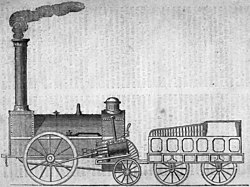Rocket
The 0-2-2 or Northumbrian wheel arrangement was first used for Stephenson's Rocket, their entry for the Rainhill Trials of 1829, a competition to choose a locomotive design for the new Liverpool and Manchester Railway. Stephenson recognised that the rules of the competition favoured a fast, light locomotive of only moderate hauling power. [2] Although George Stephenson's previous designs had been heavy four-coupled freight locomotives, Rocket was almost entirely new. Stephenson was an advocate of the adhesion railway, against the fashion of the time, and believed that the light loads for Rainhill would even allow just a single driving axle. This allowed the simplification of not requiring either a chain drive between the axles or Stephenson's invention of the external coupling rods.
Achieving adequate traction required more of Rocket's weight to be over the driving axle than the carrying axle. The heavy boiler was placed forwards, with the axle beneath it, giving a 0-2-2 layout rather than 2-2-0 . The cylinders were set at a steep angle, as used the year before for Lancashire Witch , rather than the typical vertical cylinders of this period. The cylinders were thus over the firebox and both driver and fireman shared a footplate at the same, rear, end of the engine. Previously they had often been separated to their own ends of the engine.
Northumbrian
Rocket was the only locomotive to complete the trials successfully and Stephenson became the supplier of locomotives to the L&MR.
The 0-2-2 arrangement was subsequently used by Robert Stephenson and Company on eight locomotives supplied to the Liverpool and Manchester Railway after 1829:, Meteor, Comet, Dart, Arrow, Phoenix, North Star, Northumbrian , and Majestic. Like the rebuilt Rocket, these had their cylinders set low in a near-horizontal position.
The Northumbrian type was superseded by the 2-2-0 Planet type. These reversed the layout, placing the cylinders inside, between the frames, and below the smokebox at the front. The inside cylinders were closer together, giving less of a rocking couple and so were less prone to yawing oscillation at speed. Placing the cylinders below the smokebox also permitted shorter steampipes and exhaust pipes to the blastpipe, giving better efficiency. Northumbrians were the last, and only, production locomotives with this wheel arrangement.
After the Planets, most passenger locomotives began to use a 2-2-2 arrangement, with an additional front carrying axle to give better riding at speed.


